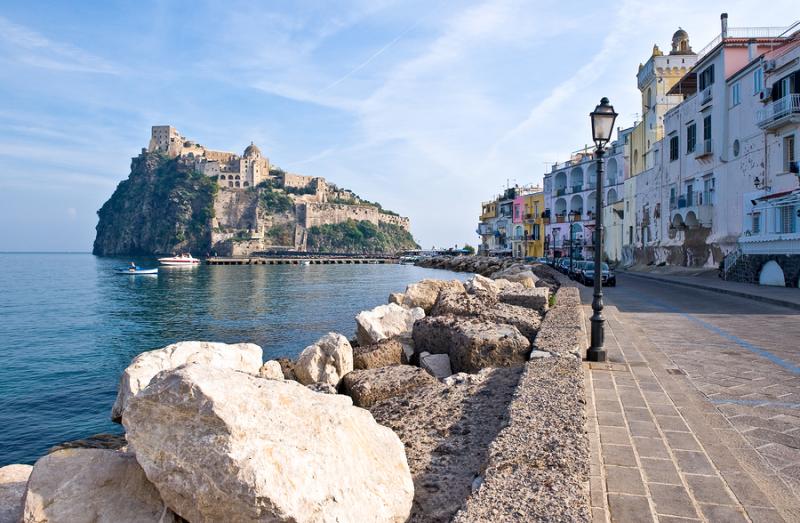Twelve thousand years ago a volcano violently exploded in the modern day suburbs of Napoli. Traces of the explosion have been discovered as widely as Siberia, Scandinavia, the Iberian Peninsula and the Alps. In addition to radically and permanently altering the European continental shelf, the eruption caused two small specks of earth to detach from the mainland.
These specks of earth are today the low lying swish of an island known as Procida and the sloping volcanic island of Ischia. Collectively they are known as the Phlegraean Islands and they are the result of the massive Phlegraean eruption, an event that will occur likely again as the underground caldera known as the Campi Flegrei or Burning Fields, is still very much active.
As the waning days of late summer float by, the Phlegraean Islands offer an historically attractive island alternative to the increasingly and incessantly crowded Capri. This two part series will explore the must-see destination on the Phlegraean Islands of Ischia and Procida. This week, we explore the island of Ischia.

Several centuries before Christ, a band of Greek mariners reportedly fleeing the Trojan Wars took to the high seas, eventually landing on Ischia. Back then the island was known as Pithecusae, so named for a tail-less monkey species that inhabited the land. The monkey island moniker was probably an early reference to pre-historic man who was both recently bipedal and thankfully lacking in tail.
Years later the Greek volcano god Typhon reportedly dueled with supreme deity Zeus. To punish Typhon for his insouciance, Zeus plunged him deep into the Mediterranean under the volcano Epomeo in the bowels of Ischia. The island is said to be Typhon’s long forgotten body, with neighborhoods across Ischia named for his body parts- Panza(belly), Ciglio (eye lash) and Testaccio (head). Ischia’s volcanic past can be experienced today in the island’s characteristically mineral forward white wines, its famous hot springs, green mud baths and Epomeo trekking. Destinations not to be missed on Ischia include:
Perched atop the hills of Panza and on the slopes of the ancient volcano of Epomeo, Casa D’Ambra Vineyards feature the highly prized Biancolella d’Ischia wine. These grapes thrive on the island’s volcanic soil and the result is an assertively flinty white wine. All can be enjoyed while sipping on the vineyard’s terrace and gazing at the panoramic views of Ischia’s Citara beach. September is wine festival month on Ischia and Casa D’Ambra welcomes visitors from all over the world. Plan a guided visit by contacting info@dambravini.com.

The Romans famously enjoyed the naturally occurring hot springs of Ischia. Fashioning thermal baths or terme around naturally occurring volcanic vents, Roman engineers built some of the first spas of the ancient world here. Cavascura, one of these baths, is still on Ischia today. Plan to spend several hours at Cavascura where you can indulge in an Ischia full body mud mask—spa experts paint the island’s green mineral mud onto guests before instructing them to bake on the sun deck for a minimum of fifteen minutes. Finally, you wash your mud mask off with warm spring water, followed by a constitutional soak in one of the terme’s private stone tubs.
 [Photo credit: Terme di Cavascura]
[Photo credit: Terme di Cavascura]
Like this article? Than you don't want to miss "Five Free Beaches on the Amalfi Coast".
You can take a dip in the Ischia sea even in the dead of winter when you visit the Sorgeto. Here volcanic vents cause hot water to pump through tide pools speckled below a series of sea facing grottos. In the summer there is a beach club on Sorgetto. But the true charms of this cove are the hot water pockets one can slip into as gentle waves come crashing ashore. The distinct temperature difference between the chilly waves and the warm bubbling volcanic pools proves particularly therapeutic in late autumn.
 [Photo credit: residenceischia, instagram]
[Photo credit: residenceischia, instagram]
This towering Medieval Castel has welcomed visitors to the Port of Ischia for well over five hundred years. It also featured prominently in the film Cleopatra and was reportedly the site of an epic row between the film’s star Richard Burton and Elizabeth Taylor. Far before Taylor and Burton where battling, King Alfonso of Aragona transferred his court here and connected the island where the Castel looms to the mainland, giving this neighborhood its modern day name of Ponte- or Bridge. This arresting vista of Ischia and the chambers within the Castel provide an uncanny opportunity to step back several centuries in time and imagine the island at the height of its medieval glory.

Leaping forward several centuries, one can visit the Mortella Gardens to revel in the delights of flourishing Post-War Ischia, which became a treasured sanctuary for Anglophone artists, poets and musicians. The most famous of these sanctuaries was the Mortella Gardens built by British composer William Walton for his beloved wife, Lady Susan Walton.

Storied landscape architect Russell Page designed the gardens to blend into the natural slopes of the cliffs of the Forio neighborhood, using local volcanic rock and incorporating diverse botanic elements to include bustling lily ponds, cactus gardens and a bird sanctuary. A world-class Steinway piano dominates an intimate concert hall where seasonal performances can be enjoyed weekly.












